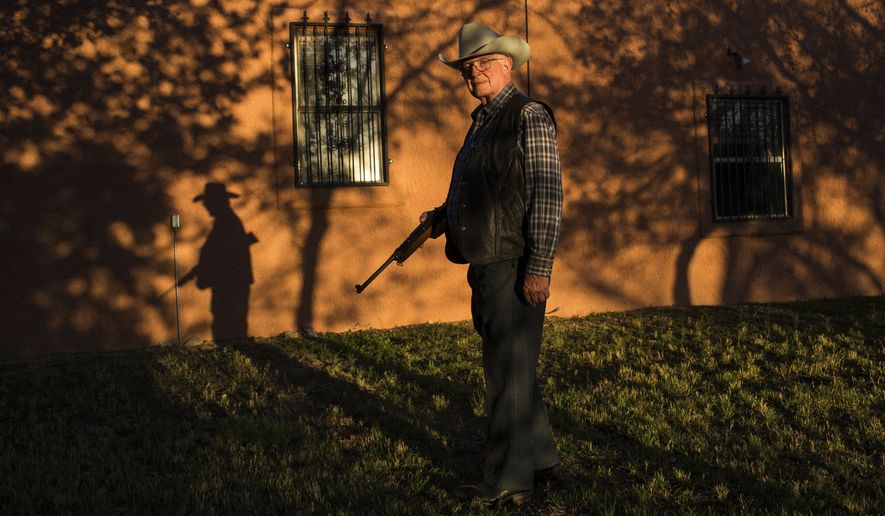Jim Chilton has long warned the government about the few strands of barbed wire that separate Mexico from the U.S. on his Arizona ranch.
He says the lack of a serious barrier, combined with the Border Patrol’s enforcement decisions, have effectively ceded miles of U.S. territory to the Sinaloa cartel, which has put scouts on his hilltops and blazed smuggling trails across his land.
That combination of weak barriers and few agents ended in violence Tuesday, he said, after a Border Patrol agent was ambushed and wounded on Mr. Chilton’s property in what authorities labeled a “shooting incident” — and which has raised anew the thorny questions of border security.
The agent, who wasn’t identified, was patrolling alone about 4:30 a.m. when the shooting occurred.
He was shot in the hand and leg and took some rounds to his body armor as well, said Mr. Chilton, citing an email he received from the Border Patrol. The agent was taken to a hospital and was expected to recover.
“Thank goodness for the vest, he survived,” the rancher said.
U.S. Customs and Border Protection said several people were arrested but didn’t give any more details. The FBI and the CBP’s office of professional responsibility were handling the investigation.
Mr. Chilton said the shooting could have been averted had the government taken border security more seriously.
“President Trump needs to complete the wall and fill the 25-mile gap, and move the Border Patrol to the international boundary rather than be located 80 miles from the boundary,” Mr. Chilton told The Washington Times by telephone.
CBP officials declined to comment on the gap in a wall along that part of the border.
The shooting took place about 10 miles north of the border in exceptionally rough terrain. The closest town is Arivaca.
Brandon Judd, a Border Patrol agent and president of the National Border Patrol Council, said the area “is one of our most dangerous stretches on the border,” and it cries out for Mr. Trump’s wall.
“If we would have had walls in this location, this shooting would have never taken place,” he said.
He also said CBP and the Border Patrol missed a chance last year to gain lasting leverage in the fight against smuggling and illegal immigration, pointing to the major drop in numbers during President Trump’s first months in office.
“President Trump single-handedly and with no help dropped illegal immigration to 45-year lows. We had the momentum on our side. It was expected that new policies and new operations would be put in place to ensure that we continued in the direction the president gave us,” he said.
“Unfortunately, our agency is still run by the Obama holdovers that gave us the failed open-border policies and operations of the past. Until serious changes are made, we will not be able to secure the border with those that refused to embrace the president’s vision on border security,” Mr. Judd said.
The area is also one of the few remaining parts of Arizona not to be protected by a significant border barrier after a fence-building spree during the Bush administration.
Nearly all of the state now has either pedestrian fencing or vehicle barriers blockading entry.
But Mr. Chilton’s 5-mile stretch of the border and perhaps 10 more miles to either side are virtually unprotected, with just the strands of barbed wire and the occasional vehicle blockade to separate the countries.
He said it’s even worse with the fencing on either side of him because it funnels traffic straight onto his property and that of his neighbors.
During a tour last year with a Washington Times reporter, Mr. Chilton showed how easy it was to slip between the barbed wire strands.
Like many other ranchers along the border, he carried his rifle with him while he was along the border — though he made sure not to let it stray onto the Mexican side.
As he surveyed the border, he said cartel scouts were likely looking down and tracking his movements from surrounding hilltops.
“Wave — you’re being watched,” he said.
Sometimes, the spotter camps are on his property, helping route drug loads around him and his cowboys. He said by one way of thinking that’s a good thing because it means fewer chances for conflict.
But sometimes they do run into each other. His people have had encounters with AK-47-toting smugglers.
He also said they have had smugglers do drug drops from ultralight aircraft — one of the more novel methods used in Arizona.
Mr. Chilton said the Border Patrol attempts a “defense in depth” strategy, which means patrolling up along the roads that run parallel to the border — yet are miles away from it. He said that cedes a large chunk of U.S. territory to the smugglers, who are controlled by the Sinaloa cartel.
“It’s like a football team. Every football team lines up on the line of scrimmage. Why does the BP line up 10, 15, 20 miles behind the line of scrimmage? You’ll lose every time,” he said.
He and his wife, Sue, say things have changed dramatically over the years. At one point, they figured up to 40,000 illegal immigrants crossed their property each year.
Then the Sinaloa cartel took over and it became primarily a drug route.
But in recent months, he said, they have seen an uptick in migrants — confirming what CBP numbers suggest about a surge in illegal immigration along the southwest border.
“I don’t know that there’s an increase in drug-packers but there is an increase in the number of people coming from Mexico, Central America and perhaps the Middle East coming through. That, I assume, is because they think this is their chance,” he said.
• Stephen Dinan can be reached at sdinan@washingtontimes.com.




Please read our comment policy before commenting.